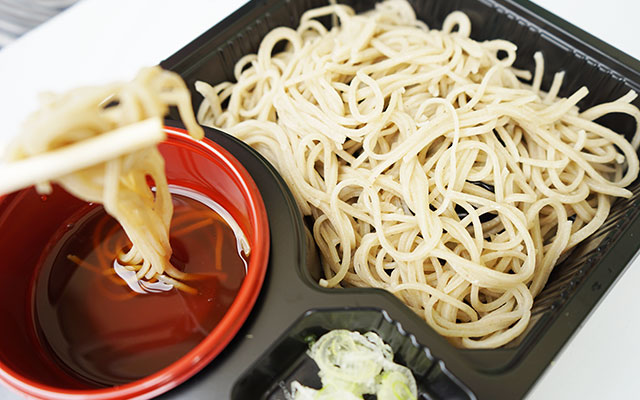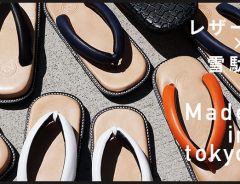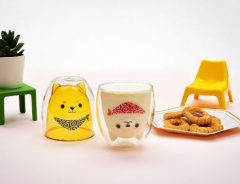
Source: Oedo Waen
The Oedo Soba And Sake Festival Proves That There’s More To Soba Than You May Think!
- Source:
- Oedo Waen
Related Article
-

Gamers Are Going Crazy For This Ergonomically Friendly Gaming Chair
-

Artist Gives Classic Film Scenes Awesome Retro Anime Makeover
-

Artist creates breakfast moment of Zen with awesome Japanese rock garden toast
-

Comfy Vibram Leather Japanese Geta Sandals Turn Traditional Footwear Casual
-

Tokyo’s New Hedgehog Cafe Is Japan’s Paradise For Prickly Cuteness!
-

3-D art bubbly scarf-wearing shiba inu glasses are your cutest drinking buddies


Let's face it. When it comes to noodle dishes in Japan, ramen has the most sex appeal. The plethora of styles, the perfect cap to a night of drinking and karaoke, and the imagery of slurping noodles in a steamy restaurant is the perfect picture of a Japanese eatery. By comparison soba, Japan's traditional buckwheat noodles, have a much more tamer image. The appeal of soba may be in its refreshing simplicity, but that doesn't mean the traditional dish is lacking in variety. One place where soba's flexible deliciousness can be seen is the Oedo Soba and Sake Festival, an ongoing event in Tokyo's Yoyogi Park--where soba and sake styles from all over the country are on display.
Even on a weekday, visitors filled every booth within minutes.
High quality soba from all over Japan courtesy of simple food stands
Oh, and they also have the best sake from all over the country.
Most foreign visitors to Japan have likely encountered soba in one of two classic serving styles: Zaru soba (笊蕎麦), chilled soba noodles topped with nori seaweed, or Kake soba (掛け蕎麦), soba served in a hot broth topped with scallions. While a multitude of soba styles are available around the country, it isn't always easy to seek them out. Fortunately at the Oedo Soba and Sake festival, hard-working chefs and soba professionals are serving up more than you could ask for. They may be working out of food stands and tents, but don't let that fool you--they're diligently churning out high quality noodles.
Painstaking and measured cutting are critical for soba preparation.
So after all that hard work, how did the soba taste? In a word, fantastic. But here's a look at some styles of soba from different prefectures that we sampled that even seasoned Japan-travelers may not have had the pleasure of getting to know.
Tartarian Buckwheat (Dattan) Soba from Niigata Prefecture
The orange tint to these noodles will immediately catch your eye and perhaps make you wonder if this is some type of curry soba (which is totally a thing), but the mysterious color is actually a result of the Tartarian buckwheat used to make the soba. Tartarian buckwheat contains 100 times more natural rutin than common buckwheat, which is said to be good for skin care, and is used to make a more bitter tasting soba (Nigasoba). Although the bitter taste may surprise many soba lovers, it is a welcome change to the traditional taste.
Daiginjo (pure rice used in sake brewing) Soba from Tochigi Prefecture
And to counter that orange soba we have some noodles that are almost glowingly white. This is thanks to using polished rice used in sake brewing and only the center part of the buckwheat to make a soba dish that is even more refreshing than the golden standard. Almost like a drink in its own thirst-quenching quality, it's a great pair with a nice cup of sake!
Cheese (!) Soba from Tokyo
Perhaps a shock for some traditionalists, but this cheesy take on soba was a clear standout at the festival that had visitors lining up for more. While it may look like a standard bowl of soba with cheese on top, the tsuyu (soba broth) mixes perfectly with it to reveal a strong, somewhat smokey flavor close to Gorgonzola or Blue Cheese, showing that even soba can pack bold flavor.
Hot Meat Soba from Tokyo
Easily one of the most filling takes on soba, the scramble of onions and meat topping a piping hot bowl of soba with a tangy broth will immediately make you think of ramen--giving you a fix for two of the best Japanese noodle dishes around.
Echizen Soba from Fukui Prefecture
Even before the event officially started, this booth had a line of people with their mind made up. Echizen Soba might have been the most "Japanese-tasting" dish available at the festival, topped with grated daikon, dried bonito flakes, it's an opportunity to double what your standard soba dish has to offer.
Nira Soba (Leek Soba) from Tochigi Prefecture
Finally we found ourselves with a light and refreshing touch on soba with the topping of leeks, a specialty in Tochigi prefecture. While it may seem like a very simple flourish, the crisp and crunchy texture of the leeks add a whole new texture to the soba as you slurp them, transforming the noodle dish into something even more satisfying in a snack-like way.
Once you've had your soba fill, you'll want to check out the impressively-stocked (over 100 brands) sake booths. Each stand is divided into regions of Japan, which have their own distinctly brewed sake to boast of. You need high quality sake to brave the cold winters of Hokkaido and Tohoku regions, so that booth was quite crowded.
Hokkaido and Tohoko boast delicious sake
Single cups range from 300-500 yen, but sampler sets are also available
And of course traditional sake cups as well
While we understand that not everyone can attend the event, it's still a wonderful example of how regional ingredients and techniques can be used to celebrate a dish that is thought of as a standard classic in Japan, and just how differently the image of that classic can be to people depending on what region of the country they hail from. Even though you may think of soba as a plain dish, try to keep in mind the variety of flavor profiles and textures this time-and-tradition protected noodle dish has the next time you are looking for some Japanese food. Details about the Oedo Soba and Sake festival can be found below.
Soba can be purchased individually at each booth, although a 700 yen ticket will cover most basic soba dishes with toppings priced as extra. In case you don't feel like soba, plenty of other Japanese festival food, such as grilled fish and karaage fried chicken are available as well.
Dates:
6/16-6/19, 2016 (Ongoing)
6/16(Thursday)/12:00AM--9:00PM
6/17(Friday)/11:00AM-9:00PM
6/18(Saturday)/10:00AM-9:00PM
6/19(Sunday)/10:00AM-9:00PM
*Last order for soba is 7:30PM